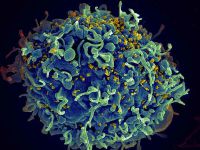Difference between revisions of "About-cancer/causes-prevention/risk/infectious-agents/zh"
(Created page with "宫颈癌筛查可用于检测子宫颈中的HPV感染迹象。 尽管无法治愈HPV感染本身,但可以治疗这些感染随时间推移可能引起的宫颈异常。...") |
(Created page with "=== 人类T细胞白血病/淋巴瘤病毒1型(HTLV-1) ===") |
||
| Line 33: | Line 33: | ||
宫颈癌筛查可用于检测子宫颈中的HPV感染迹象。 尽管无法治愈HPV感染本身,但可以治疗这些感染随时间推移可能引起的宫颈异常。 有关更多信息,请参见HPV和癌症以及人乳头瘤病毒(HPV)疫苗和HPV和巴氏检测实况报道。 | 宫颈癌筛查可用于检测子宫颈中的HPV感染迹象。 尽管无法治愈HPV感染本身,但可以治疗这些感染随时间推移可能引起的宫颈异常。 有关更多信息,请参见HPV和癌症以及人乳头瘤病毒(HPV)疫苗和HPV和巴氏检测实况报道。 | ||
| − | === | + | === 人类T细胞白血病/淋巴瘤病毒1型(HTLV-1) === |
HTLV-1 can cause an aggressive type of non-Hodgkin lymphoma called adult T-cell leukemia/lymphoma (ATLL). This virus spreads via blood (by sharing needles or through transfusions), through sexual contact, and from mother to child in the womb or via breastfeeding. Infection with this virus is more common in Japan, Africa, the Caribbean, and South America than in the United States. Most people with HTLV-1 infection do not have any symptoms or develop disease. | HTLV-1 can cause an aggressive type of non-Hodgkin lymphoma called adult T-cell leukemia/lymphoma (ATLL). This virus spreads via blood (by sharing needles or through transfusions), through sexual contact, and from mother to child in the womb or via breastfeeding. Infection with this virus is more common in Japan, Africa, the Caribbean, and South America than in the United States. Most people with HTLV-1 infection do not have any symptoms or develop disease. | ||
Revision as of 18:41, 31 October 2019
Contents
传染媒介
某些感染因子,包括病毒,细菌和寄生虫,可能导致癌症或增加癌症形成的风险。 一些病毒可以破坏通常使细胞生长和增殖受到控制的信号传导。 同样,某些感染会削弱免疫系统,使人体抵抗其他致癌感染的能力降低。 一些病毒,细菌和寄生虫也会引起慢性炎症,这可能导致癌症。 与癌症风险增加有关的大多数病毒可以通过血液和/或其他体液从一个人传播到另一个人。 如下所述,可以通过接种疫苗,进行无保护的性行为和不共用针头来降低感染风险。
爱泼斯坦巴尔病毒(EBV)
EBV是一种疱疹病毒,会引起单核细胞增多症以及某些类型的淋巴瘤和鼻喉癌。 EBV最常通过与唾液接触而传播,例如通过亲吻或共享牙刷或水杯来传播。 它也可以通过性接触,输血和器官移植而传播。 EBV感染是终生的。 全球超过90%的人一生中都会感染EBV,并且大多数人不会出现任何症状。 没有疫苗可以预防EBV感染,也没有针对EBV感染的特殊治疗方法。
乙型肝炎病毒和丙型肝炎病毒(HBV和HCV)
HBV或HCV的慢性感染可导致肝癌。 两种病毒均可通过血液传播(例如,通过共用针头或通过输血),并在出生时从母亲传播给婴儿。 此外,乙肝病毒可通过性接触传播。
自1980年代以来,美国和大多数其他国家/地区的婴儿已常规接种了HBV感染疫苗。 专家建议未接种HBV疫苗且感染HBV的风险较高的成年人应尽快接种疫苗。 疫苗接种对于与人血接触的医护人员和其他专业人员尤其重要。
美国疾病控制与预防中心(CDC)还建议对美国1945年至1965年之间出生的每个人以及其他感染HCV感染风险增加的人群进行HCV检测。 尽管目前没有针对HCV的疫苗,但新疗法可以治愈人们的HCV感染。 如果您认为自己可能有HBV或HCV感染的危险,请询问您的医生以进行检查。 这些感染并不总是会引起症状,但是测试可以显示您是否感染了病毒。如果是这样,你的医生可能会建议治疗。 另外,您的医生可以告诉您如何避免感染他人。
人类免疫缺陷病毒(HIV)
HIV是导致获得性免疫缺陷综合症(AIDS)的病毒。 艾滋病毒本身并不会引起癌症,但是感染艾滋病毒会削弱免疫系统,使人体抵抗其他导致癌症的感染的能力降低。 感染HIV的人罹患多种癌症的风险增加,尤其是卡波西肉瘤,淋巴瘤(包括非霍奇金淋巴瘤和霍奇金病)以及子宫颈癌,肛门癌,肺癌,肝癌和咽喉癌。
HIV可以通过血液和性接触传播。 与其他男人无保护的性行为的男人以及共用注射针头的人们感染艾滋病毒的风险最高; 与多个伴侣无保护的性行为的异性恋个体处于次高风险。
人们在开始出现症状之前可能已经感染了艾滋病毒多年。 如果您认为自己有感染HIV的危险,请向您的医生询问是否接受检测。 如果您测试呈阳性,则您的医生可以开出高效的抗病毒药,并告诉您如何避免感染他人。 有关更多信息,请参见HIV感染和癌症风险情况说明书。
人乳头瘤病毒(HPV)
高危类型的HPV感染几乎导致所有子宫颈癌。 它们还引起大多数肛门癌以及许多口咽癌,阴道癌,外阴癌和阴茎癌。 高风险的HPV容易通过直接的性接触传播,包括阴道,口交和肛交。 已经开发了几种疫苗来防止感染引起大多数与HPV相关的癌症的HPV类型。 在美国,专家建议孩子在11或12岁时接种疫苗,但是9岁以下的孩子和26岁的成人也可以接种疫苗。
宫颈癌筛查可用于检测子宫颈中的HPV感染迹象。 尽管无法治愈HPV感染本身,但可以治疗这些感染随时间推移可能引起的宫颈异常。 有关更多信息,请参见HPV和癌症以及人乳头瘤病毒(HPV)疫苗和HPV和巴氏检测实况报道。
人类T细胞白血病/淋巴瘤病毒1型(HTLV-1)
HTLV-1 can cause an aggressive type of non-Hodgkin lymphoma called adult T-cell leukemia/lymphoma (ATLL). This virus spreads via blood (by sharing needles or through transfusions), through sexual contact, and from mother to child in the womb or via breastfeeding. Infection with this virus is more common in Japan, Africa, the Caribbean, and South America than in the United States. Most people with HTLV-1 infection do not have any symptoms or develop disease.
Blood is routinely screened for HTLV-1 in the United States. There is no vaccine to prevent infection with this virus and no treatment if you are infected. If you think you may be at risk for HTLV-1 infection, ask your doctor about being tested. If you test positive, your doctor can tell you how to keep from infecting other people and monitor you for HTLV-1-induced disease.
Kaposi Sarcoma-Associated Herpesvirus (KSHV) Kaposi sarcoma-associated herpesvirus (KSHV), also known as human herpesvirus-8 (HHV-8), can cause Kaposi sarcoma. KSHV can also cause primary effusion lymphoma and multicentric Castleman disease.
KSHV is most commonly spread through saliva. It can also be spread through organ or bone marrow transplantation, and there is some evidence that it can be spread by blood transfusion, although this risk is minimized by practices followed in the United States such as blood storage and removal of white cells.
KSHV infection is generally limited to certain populations, and the way KSHV is spread varies among these populations. In sub-Saharan Africa and certain regions of Central and South America, where KSHV infection is relatively common, it is believed to spread by contact with saliva among family members. In Mediterranean countries (Italy, Greece, Israel, Saudi Arabia), where KSHV infection is present at intermediate levels, it is thought to spread by contact among children and by ill-defined routes among adults. Finally, in regions where KSHV infection is uncommon, such as the United States and Northern Europe, it appears to be mostly transmitted sexually, especially among men who have sex with men.
Most people infected with KSHV do not develop cancer or show any symptoms, although those who also have HIV infection or are immunosuppressed for other reasons are more likely to develop KSHV-caused diseases. There is no vaccine to prevent KSHV infection and no therapy to treat infection. Men who have sex with men may be advised to avoid oral–anal contact (including use of saliva as a personal lubricant). And people who are infected with HIV can lower their risk of KSHV-related complications by using antiretroviral therapy.
Merkel Cell Polyomavirus (MCPyV)
MCPyV can cause Merkel cell carcinoma, a rare type of skin cancer. Most adults are infected with MCPyV, with transmission most likely occurring through casual direct (i.e., skin-to-skin) or indirect (i.e., touching a surface that an infected person has touched) contact in early childhood. The risk of Merkel cell carcinoma is greatly increased in elderly people and in younger adults with who are infected with HIV or are immunosuppressed for other reasons. Infection does not generally cause symptoms, and there are no treatments for MCPyV.
Helicobacter pylori (H. pylori)
H. pylori is a type of bacterium that can cause noncardia gastric cancer (a type of stomach cancer) and a type of lymphoma in the stomach lining, gastric MALT lymphoma. It can also cause stomach ulcers. The bacterium is thought to spread through consumption of contaminated food or water and direct mouth-to-mouth contact. The CDC estimates that approximately two-thirds of the world’s population harbors H. pylori, with infection rates much higher in developing countries than in developed nations. In most populations, the bacterium is first acquired during childhood.
If you have stomach problems, see a doctor. Infection with H. pylori can be detected and treated with antibiotics.
For more information, see the Helicobacter pylori and Cancer fact sheet.
Opisthorchis viverrini
This parasitic flatworm (fluke), which is found in Southeast Asia, can cause cholangiocarcinoma (cancer of the bile ducts in the liver). People become infected when they eat raw or undercooked freshwater fish that contain the larvae. Antiparasitic drugs are used to treat the infection.
Schistosoma hematobium
This parasitic flatworm (fluke), which lives in certain types of freshwater snails found in Africa and the Middle East, can cause bladder cancer. People become infected when infectious free-swimming flatworm larvae burrow into skin that has come into contact with contaminated fresh water. Antiparasitic drugs are used to treat the infection.
